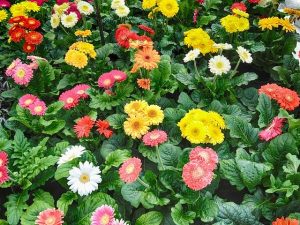Asters are easy to grow and make a colourful display. Companion planting asters, also known as michaelmas daisies, is beneficial in many ways. Read on to find out just how beneficial, and what asters are good companions too.
Why Companion Plant?

Companion planting, or polyculture has been practised for many centuries around the world. It emulates nature, look at hedgerows and woodlands and you will see natural companion planting. To find out more on the history of companion planting follow this link.
It was only in the late 19th and on to the 20th century that monoculture, the growing of a single crop became fashionable. This was mainly due to large agricultural companies and the technological advances in farm machinery. Now in the 21st century many farmers are realising the benefits of companion planting and rediscovering the methodology.
The Benefits Of Companion Planting

Many gardeners follow the methods used in large agricultural farms but on a smaller scale. Like monocropping, and adding chemicals to balance soil conditions and that’s fine. But if you care for the environment, your health, and the health of wildlife, then companion planting is the answer.
If you plant a single crop, and for example let’s say cabbage. You create a large target for any pests that feed on cabbage, like cabbage whites and cabbage moths. It’s like a one stop feeding station for pests.
Now take that same cabbage crop and inter sow with say, sage, mint, rosemary, thyme, garlic, or onions, and you’ve just made it much more difficult for the pests to find the cabbage. Allow some of those plants to bloom, and you attract a heavy traffic of pollinators that will also deter the pests. Science backs up this theory and there have been many good academic papers written on this subject.
Companion Planting Asters

Now we have dealt with the many reasons for companion planting, let’s look at companion planting asters and the benefits of doing so. Asters are butterfly magnets, and this is great if you have something that needs pollinating growing nearby. They flower from mid Summer, right up to late September depending on the variety.
Asters make great companion plants for most garden plants, including other flowers and vegetables.
The Benefits Of Companion Planting Asters

As we’ve already established, asters attract many butterflies, and this makes them a great addition to the vegetable patch. Asters also repel nematodes, beet leaf hoppers and many other pests. Particularly good for companion planting with asparagus, asters do well with almost every plant.
Due to the high number of large butterflies flying to and from the aster flowers, many pests will be deterred from visiting your garden.
What Not To Grow With Asters

There is really only one plant that falls into this category, and that’s corn. Asters can transmit disease to corn plants so it’s best to keep them apart.
Have you grown asters? Did you notice any problems with pests? If so please let me know in the comments section below.

